|
Forest & Shade Tree –
Insect & Disease Conditions for Maine
September 23, 2021
In This Issue
Browntail Moth (Euproctis chrysorrhoea)
In late August, we began observing feeding damage from young browntail moth caterpillars becoming very apparent in many areas, especially in Kennebec County. One thing of recent note we have observed is a few webs that have deceased browntail moth caterpillars on the outside of the web. It seems to us that there may be a pathogen to thank, although we can’t say for sure. Further investigation will reveal if this is a widespread phenomenon. In addition, many of the caterpillars, especially around the Capital Region, are nearing completion of their winter webs.
If you are noticing a lot of damage from browntail moth on your property now, it is not too early to plan your response to reduce impacts next year. Plan to remove webs within reach once the trees are dormant. Communicate with your neighbors in case they are not aware of the problem. If you have a lot of webs out of reach from the ground, you may want to contract with a licensed pesticide applicator for treatment or a licensed arborist (PDF) for web removal and destruction. Consider working with your neighbors to manage this pest.
 Image: Nearly constructed winter web with dead caterpillars, Augusta, Maine.
Emerald Ash Borer (Agrilus planipennis) – Regulatory Update
In case you missed it, the latest emergency order for emerald ash borer (EAB) was announced on August 30, 2021. The emergency order covers Albany Township, Lovell, Norway, Otisfield, Oxford, Stoneham, Stow, Sweden, and Waterford in southern Oxford County and limits movement of ash and hardwood firewood from those areas, in addition to the existing quarantine area. This latest expansion of the regulated area in Maine was in response to the detection of EAB in Bridgton, increasing the likelihood that EAB might have already expanded beyond the extents of the previous regulated area.
Emerald Ash Borer (Agrilus planipennis) – Girdled Trap Tree Peeling
This autumn, we will once again be holding log-peeling workshops for volunteers who girdled ash trees to survey for EAB. Our workshops will be held outdoors, and we will be spacing out the workstations to maintain adequate social distancing between people. We have scheduled log peeling workshops in 5 locations:
- Oct 6 in Stockholm for ALL trees from the northern quarantine area (PDF) and any others in northern Maine
- Oct 13 at Acadia National Park for trees NOT in a quarantine area
- Oct 19 in Gray for ALL trees from the southern quarantine and emergency order area (PDF) and any others in southern Maine.
- Oct 21 in Augusta for trees NOT in a quarantine area
- Nov 3 in Old Town for trees NOT in a quarantine area
All log peeling events will begin at 9 am.
If you have girdled an ash tree for this program, email colleen.teerling@maine.gov to coordinate processing of your tree. Indicate which of the five peeling workshops you are interested in participating in, whether you would like to take part in peeling the tree, as well as a daytime phone number. Please note that if your tree is from an EAB regulated area, you must bring your bolts to the collection point in that area (either Gray or Stockholm). If you are unsure about the boundaries of these zones, please check our EAB web page. If you would need assistance in felling your tree, or if you would like us to pick it up, please let us know. We will assist if possible.
After we hear from you, if you are felling your own tree, we will send instructions on how to buck your tree into sections and details about the locations. Please include a phone number, as this will help us coordinate.
Our thanks to everyone who girdled an ash tree this year to assist in monitoring for and tracking the spread of EAB.
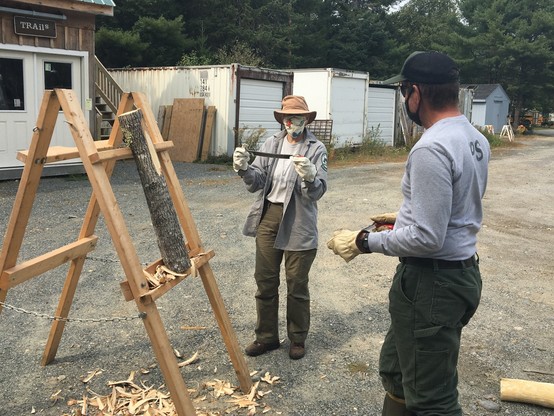 Image: Outdoor girdled tree peeling in 2020. Credit: J. Wheeler, Acadia National Park.
Lymantria dispar
In a stunning example of rapid population growth, Maine experienced approximately 55 thousand acres of defoliation damage from Lymantria dispar (formerly gypsy moth) in 2020. This damage was part of a larger contiguous outbreak extending into New Hampshire and was concentrated primarily along the border in southern Oxford County. In addition to previously reported areas in our August conditions report, new areas with great numbers of egg masses likely to show continued population growth next season include an area around Nicatous Lake in T3 ND and another area in Passadumkeag off the Caribou Road. These areas were brought to our attention by the public and we are likely to learn of additional areas this way during the upcoming winter, highlighting just how important this public reporting is. Once the leaves fall, we continue to ask that areas with large numbers of egg masses outside of southern Oxford County be reported to the Insect and Disease lab. Unfortunately, this forest pest will be back in force in 2022, but this way we will have a better idea of where to expect to encounter the most problems ahead of time.
Partial harvests in forest areas undergoing severe defoliator outbreaks like this should be delayed whenever possible until the outbreak subsides, and trees have had an opportunity to recover from that stress. Although harvests can be important in improving forest health in the long-term, harvesting represents an additional stress both at the time it occurs and for a while afterwards. Residual trees that have experienced significant defoliation may lack the resources to tolerate these additional stresses. In addition, these residual trees can experience higher pest pressure following harvest as pest populations tend to be more concentrated on the fewer stems remaining. A good summary of the issue can be found in UNH Cooperative Extension Pest Fact Sheet 70 (PDF).
Spruce Budworm (Choristoneura fumiferana)
October marks the beginning of the end of the 2021 SBW pheromone trap monitoring season as we head out into the woods in earnest to start collecting traps and counting the moths captured within. With visual defoliation becoming more apparent in northern Maine over the last two monitoring seasons, we expect moth captures will have increased over the numbers recorded in 2020. At the same time pheromone traps are collected, weather permitting, branch samples will also be collected at monitoring sites to survey for overwintering spruce budworm larvae. While we are extremely grateful to the Canadian Forest Service lab in Fredericton that has previously processed our branch samples for us, we’re also very excited to be able to process these branch samples right here in Maine this season at a new lab facility set up for this process at the University of Maine – Orono. We look forward to reporting on preliminary SBW monitoring data over the upcoming months and thank our SBW program cooperators statewide for their assistance with this large and long-term project.
White-margined Burrower Bug (Sehirus cinctus)
The Insect and Disease Lab received a number of inquiries this past month surrounding the identity of some unusual looking insects. These colorful creatures, in the taxonomic group referred to as true bugs, turned out to be the nymphs of the white-margined burrower bug. Despite their alarming appearance and numbers, these are largely harmless and feed on a variety of common weeds here in Maine. An unusual characteristic for this insect is that it happens to be one of a few species documented to exhibit maternal care. The mothers not only allow offspring to hitchhike on their backs, but go so far as to actually provision the immature nymphs with food (usually seeds) during early development. These congregations of nymphs will eventually go their separate ways as they mature.
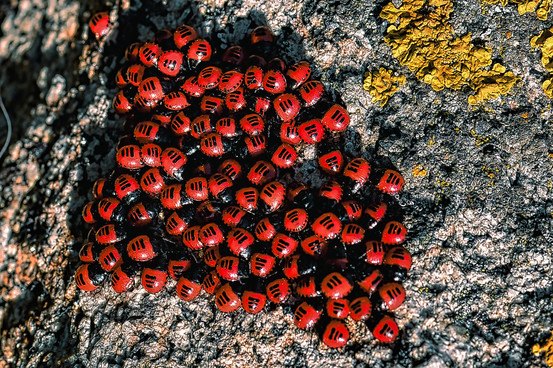 Image: White-margined burrower bug nymphs. Credit: Eric Meeks.
Woolly Oak Aphid (Subfamily Phyllaphidinae)
This past month we received many reports of masses of white flocculence occurring on red oak as well as littering the ground beneath oak trees. As of this report, the sightings are fairly widespread and include observations from Lincolnville, Manchester, Mattawamkeag, Sebago, Stetson and Windsor.
The subfamily Phyllaphidinae contains roughly 15 species in 4 genera (Diphyllaphis, Machilaphis, Phyllaphis, Stegophylla). Both winged and wingless life stages possess many wax secreting glands and are therefore usually covered in a waxy coating. This subfamily of aphids has not been studied extensively so not much is known about their distribution. As with other insects that produce the cottony flocculence, these insects produce this material for the dual purpose of serving as a mechanical barrier to predators as well as providing protection against desiccation.
 Images: (left) Flocculence on the underside of a red oak leaf; (middle and right) Wingless (apterus) aphids under magnification.
Beech Leaf Disease
Beech leaf disease (BLD) continues to be found in areas further away from the initial finds in the Midcoast area of Maine. Verified reports from Islesboro, Montville, Searsmont and the Penobscot Experimental Forest in Bradley/Eddington broaden the area considered to be generally infested with BLD. Further, reliable reports of BLD have come from Deer Isle, although these have not yet been confirmed. Most of the eight BLD long-term monitoring plots have been set up by the Maine Forest Service (MFS) and US Forest Service (USFS) with plans to establish eight more plots next year, as well as to remeasure plots established this year. BLD is a disease of beech trees, affecting leaves thought to be caused by a microscopic roundworm (a nematode). Since the first report of BLD in Cleveland, OH in 2012, BLD has spread to the east reaching Maine, where it was reported by forestland owners and confirmed by MFS and USFS pathologists in May 2021. Researchers are still not sure how the disease is spread and many other aspects of the disease remain unknown and are a focus of research efforts. For reports of or questions about BLD, please contact Aaron.Bergdahl@maine.gov, (207) 287-3008.
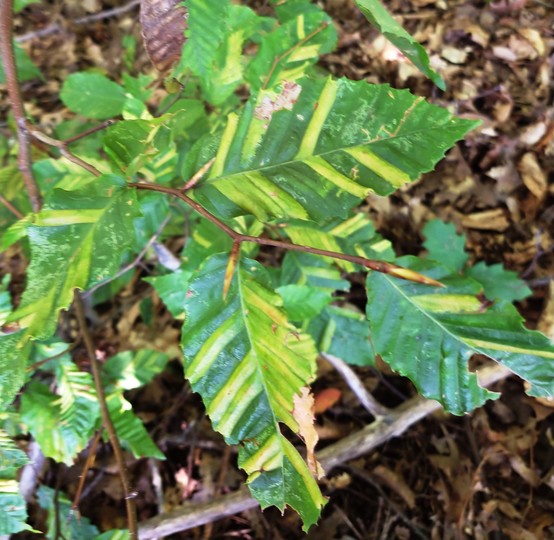 Image: late-season symptoms of beech leaf disease on American beech with interveinal bands turning chlorotic (yellow) as the season progresses toward leaf senescence.
Early Fall Coloration and Senescence
Early fall coloration has been seen and reported in several areas of Maine. In a typical year, this may be natural for some species of trees on certain sites, like red maple growing in wet/swampy areas. Also, trees are genetically different and some species, or even individuals within a species, are programmed to stop producing chlorophyll a bit earlier than others, exposing the red, yellow and orange pigments responsible for autumn leaf colors. While these examples of early coloration are more natural processes, other early fall coloration and senescence can be associated with stress. If you see a tree exhibiting early fall coloration/senescence, check the tree for injuries or signs of insect or pathogens. Look for evidence of site changes like disturbed soil in a tree’s root zone, changes in soil grade or signs of herbicide use (growth/leaf deformation paired with a completely weed-free lawn or fields of crops nearby). Trees next to roads are often more stressed than trees growing in the forest due to conditions like drought-prone growing sites, soil salinity from road salts, etc. (Roadside trees are highly visible and therefore are commonly noticed and reported when they turn color early). In the absence of these issues, and when early coloration is seen across larger areas, environmental conditions may be to blame.
Factors causing early fall coloration and/or senescence are often out of our control, like this year’s drought conditions experienced throughout May and June that undoubtedly have lasting effects later in the season, despite record rainfall in July. Conversely, high rainfall can lead to inundation of the root zone for prolonged periods in less well-drained areas or heavier soils, starving roots of oxygen and leading to stress and thus early fall coloration. More concerning is when trees senesce early and drop leaves before fall coloration occurs. This has been reported in some areas of Maine, and the reasons for this are not totally clear. Compounding stressors of the growing season may be to blame, although some tree pathogens may be involved as well (see the next article on Septoria Leaf Spot of Maples).
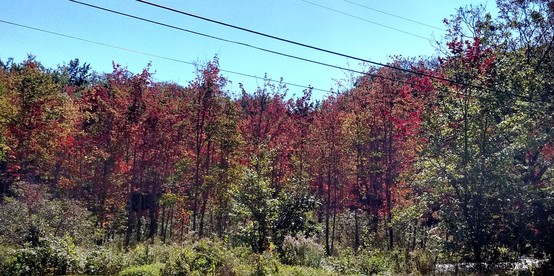 Image: Early coloration of red maples in an area with poor drainage.
In forest settings, there is little that can be done to address stress, except hope for favorable conditions during future growing seasons. In horticultural settings, however, stress factors can be addressed through cultural practices like regular watering, but not overwatering, fertilizing trees during spring or fall (not during mid- to late summer as this may cause late flushes of succulent growth that will be killed at first frost) and mulching trees to reduce resource competition and likelihood of injury from lawn equipment. Also, keeping an eye out for pests and properly managing them will ensure less stressed trees that will likely exhibit excellent fall color at the ‘right’ time.
Septoria Leaf Spot on Maples (Septoria spp.)
Septoria leaf spot of maple has been reported in the Farmington area and has been seen in several parts of Belgrade, Readfield, Manchester, Augusta, Gardiner, West Gardiner and Litchfield, primarily affecting sugar maples (these reports are very recent and this disorder may be happening in other parts of the state as well). This has led to the early senescence and defoliation of sugar maple leaves before their typical famous display of colors in autumn. Luckily, this is the most serious impact of the disease due to its late-season nature. This is because the leaves of impacted trees have already done the large majority of their photosynthesis for the year, so losing them now represents a very minor tree stress. Symptoms include yellowing of leaves with stippled brown spots that expand and coalesce, in some cases turning most of the leaf area brown. Observation under a microscope reveals numerous tiny black specks on the upper leaf surface that are the fungus’s spore-producing structures.
Neighboring states have reported localized outbreaks of Septoria leaf spot of maple in years past, but this disorder has not been reported in at least the past six years in Maine. The occurrence of this disease this year is likely due to the record rainfall in July, creating perfect conditions for the proliferation of fungal leaf spots. It is important to note that outbreaks of Septoria leaf spot of maple are thought to occur here and there and are not impacting maple species across a wide geographical range. Thus, we can still count on the vibrant fall foliage of maples (and many other species) across most of Maine in the coming weeks.
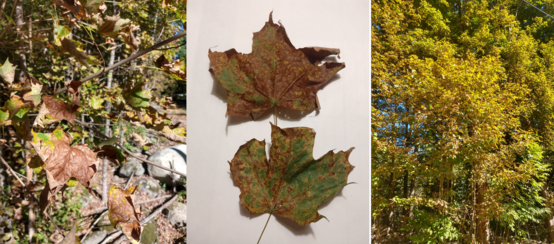 Images: (left) Close-up of a sugar maple branch with senescing leaves without typical vibrant fall coloration; (middle) Maple leaves with lesions of varying severities of leaf lesions and necrosis (death); (right) Sugar maple trees showing uncharacteristic dull yellow coloration in the process of early senescence and defoliation (especially in the lower crown where fungal diseases are often most prevalent) due to infection by Septoria leaf spot of maple.
From the September 7, 1994 Condition Report:
“Golf Course ‘Worms’: We have had a number of reports this season of large worms wandering around golf courses! Most, if not all, of these have involved one of the hornworms (Sphinx or hawk moth larvae). A number of species have been unusually common this season. As fall approaches and they reach maturity, they leave the host trees (often ash) and seek a pupation site. Due to their large size, 3”±, and often colorful marks they can attract attention, especially where grass is short and the foot traffic has their eyes on the ground.”
(August's Condition Report listed some talks at the Common Ground Fair- the fair has since been cancelled).
November 3–4, Virtual – Save the Date. White Pine Weevil, Management and Tree Improvement. The Atlantic Tree Improvement Council (AtlanTIC) in conjunction with the Canadian Woodlands Forum and the Canadian Wood Fibre Centre will be hosting a virtual workshop on white pine weevil management and tree improvement. The white pine weevil is a major pest of white pine, Sitka spruce, white spruce, jack pine, Norway spruce and other species in Canada. This event will bring together white pine weevil experts, tree improvement specialists, forest managers and others to share knowledge associated with white pine weevil management in our forests and for the purpose of accelerating the implementation of plans to develop trees resistant to weevils. More information will be available soon.
Conditions Report No. 6, 2021
Online
Department of Agriculture Conservation & Forestry Maine Forest Service – Forest Health and Monitoring
Contributors: Aaron Bergdahl, Amy Emery, Mike Parisio, Colleen Teerling, and Thomas Schmeelk
Unless otherwise noted, images by Maine Forest Service, Forest Health and Monitoring, DACF
|